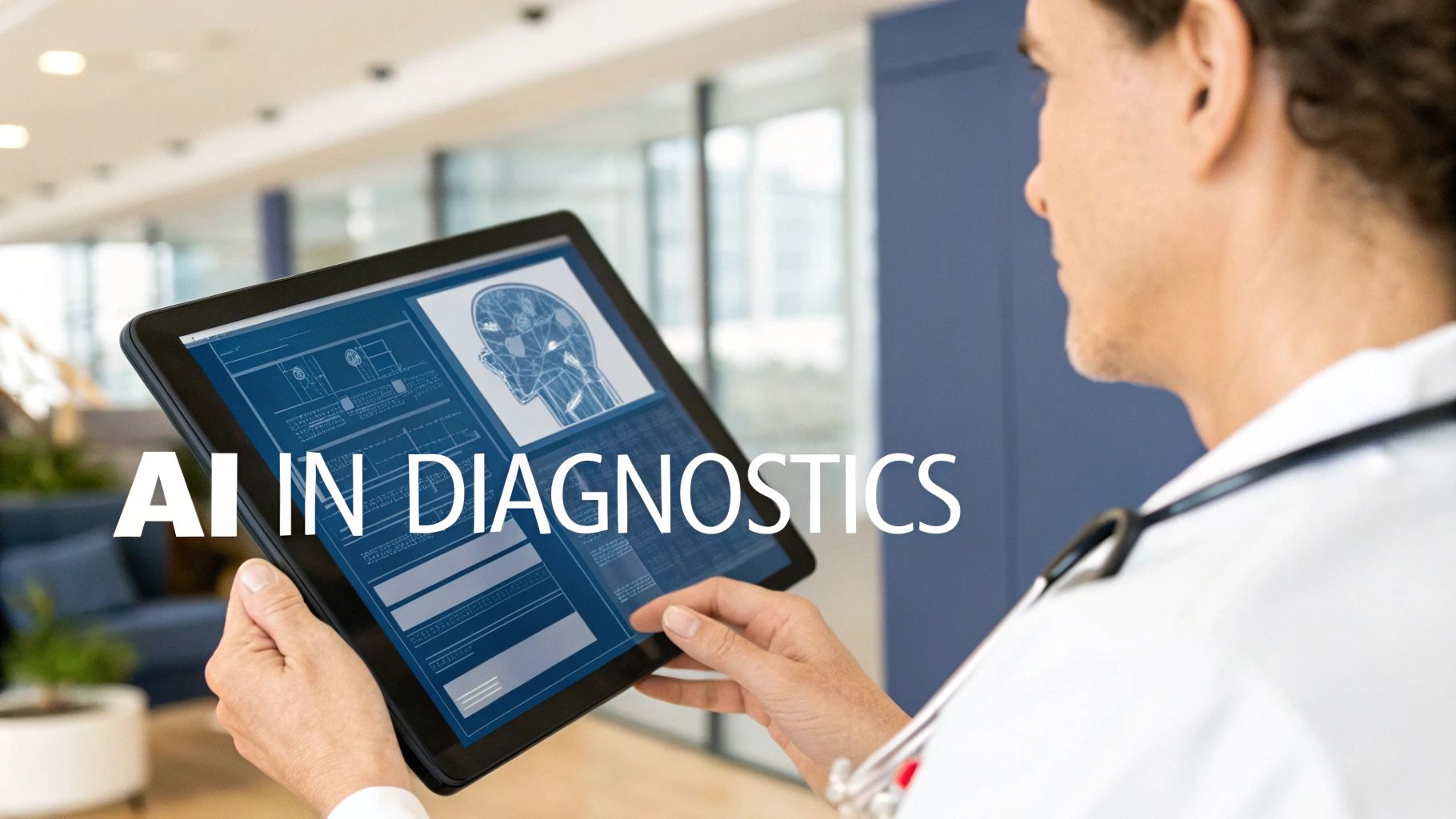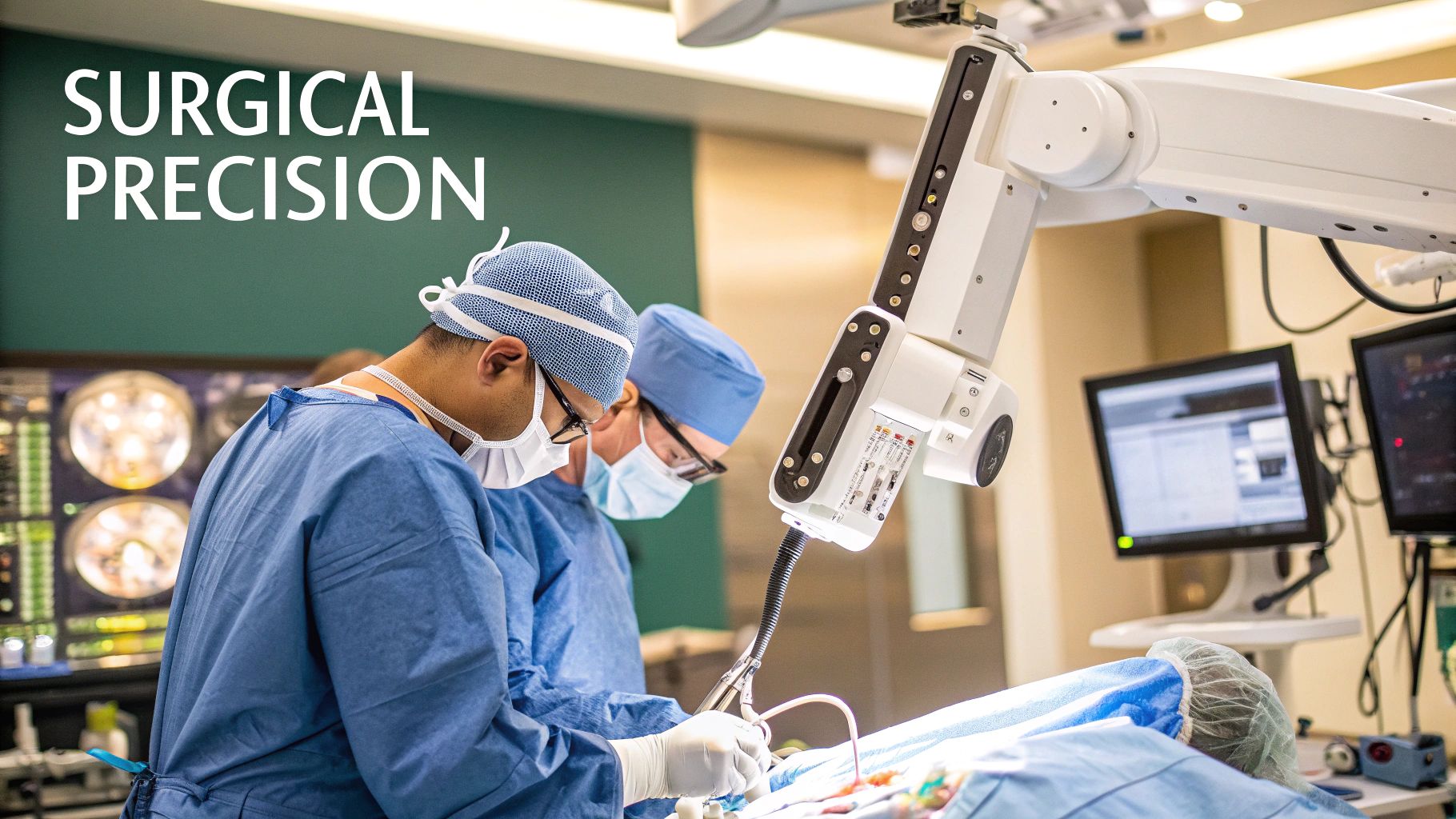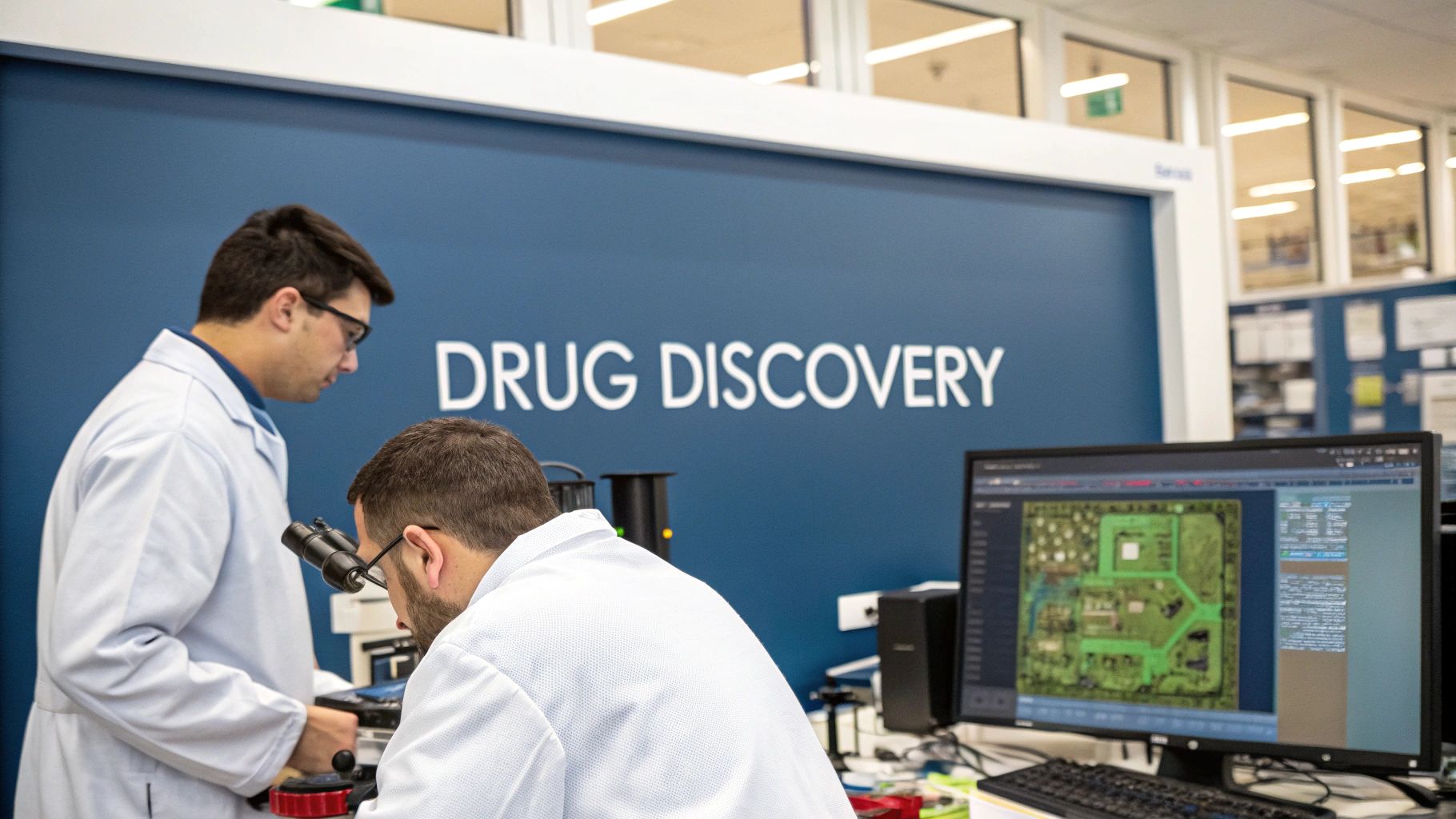Revolutionary Applications of AI in Healthcare: New Frontiers in Patient Care
The Current State of AI in Modern Healthcare
AI is bringing major changes to healthcare by making treatments more effective, operations more efficient, and costs more manageable. These changes stem from the increased availability of medical data, better AI algorithms, and growing evidence that AI can solve real healthcare problems.
Key Drivers of AI Adoption
Healthcare generates massive amounts of data every day – from patient records to medical scans. This data feeds AI systems that can spot patterns and make predictions far beyond human capabilities. For example, AI can examine medical images and find tiny signs of disease that even experienced doctors might miss.
The high costs of delivering care have also pushed healthcare providers to look at AI solutions. Simple AI tools like chatbots can handle basic patient questions, which lets medical staff focus on more complex cases. This not only cuts costs but also makes the experience better for patients who get faster responses to their concerns.
Real-World Applications and Impact
AI is making a difference across healthcare, from spotting diseases to developing new medicines. In medical imaging, AI programs analyze X-rays and MRIs to find conditions like cancer and heart disease early on, when treatment works best. This leads to better outcomes for patients.
In drug research, AI speeds up the process of finding new treatments. By processing huge amounts of biological information, AI helps scientists identify promising drug candidates much faster than traditional methods. This means potentially life-saving medicines can reach patients sooner.
AI also changes how medical professionals work day-to-day. When AI handles paperwork and provides quick insights about patient conditions, doctors can spend more time actually talking with patients. Picture a doctor who uses AI to quickly review patient data and suggest possible diagnoses – this gives them more time to explain things to patients and develop personalized treatment plans.
Challenges and Future Directions
While AI offers great benefits for healthcare, some important issues need attention. Keeping patient data private and secure is crucial, as is making sure AI systems don't have built-in biases. More testing is needed to ensure AI tools are reliable and safe for medical use. Clear rules and ethical guidelines will help healthcare providers use AI responsibly. Despite these challenges, AI's proven benefits suggest it will become an even bigger part of healthcare delivery in the years ahead.
Understanding AI's Impact on Medical Diagnostics
Artificial intelligence is bringing major improvements to how doctors diagnose diseases. By analyzing medical data, spotting subtle patterns, and supporting clinical decisions, AI tools help doctors identify conditions faster and more accurately than ever before. Let's explore how AI is changing medical diagnostics and making quality healthcare more accessible.
Improving Accuracy in Disease Detection
AI shines brightest when it comes to making diagnoses more precise. For instance, AI systems can examine medical images like X-rays, CT scans, and MRIs to find abnormalities that human eyes might miss. This means doctors can catch conditions like cancer, heart problems, and brain disorders much earlier. The real power comes from AI's ability to look at everything together – patient history, lab work, and genetic data – giving doctors a complete picture to make better diagnostic decisions.
Making Diagnosis Faster and More Efficient
Speed matters tremendously in medical emergencies. AI helps by cutting down the time it takes to analyze patient information and suggest possible diagnoses. This is especially valuable when treating time-sensitive conditions like strokes or heart attacks, where every minute counts. As AI handles more of the data analysis, doctors can focus their time and energy on treating patients while still having access to AI-supported insights.
Real-World Success Stories
AI diagnostic tools are already making a difference in hospitals and clinics. One notable example is in detecting Diabetic Retinopathy, which can cause blindness if not caught early. AI systems now spot signs of this condition with remarkable accuracy, helping save people's eyesight through early treatment. Similarly, AI analysis of heart readings (ECGs) helps doctors identify irregular rhythms and predict potential heart problems before they become serious. This allows for preventive care tailored to each patient's needs.
Keeping the Human Touch
While AI brings powerful capabilities to medical diagnosis, it works best as a tool to support doctors rather than replace them. The final decisions about diagnosis and treatment still rest with medical professionals who combine AI insights with their expertise and direct patient care. This partnership between human judgment and AI analysis leads to better outcomes for patients. The benefits extend beyond individual care too – by 2025, experts predict AI will help reduce healthcare costs by $13 billion, partly through more efficient diagnosis. This makes quality healthcare more affordable and available to more people.
Maximizing ROI Through Strategic AI Implementation
While AI has proven valuable for medical diagnosis, its benefits extend far beyond clinical applications. Healthcare organizations can achieve significant cost savings by implementing AI across their operations strategically. Let's explore some practical ways organizations are using AI to improve their bottom line.
Identifying High-Impact Opportunities
Hospitals are already seeing real results by using AI to manage resources more effectively. For instance, AI systems can predict when patients will be discharged and optimize bed assignments accordingly. This reduces wait times and keeps beds filled – a key factor in hospital revenue. AI can also detect patterns that help prevent costly hospital-acquired infections before they spread. These practical applications show how targeted AI use can quickly improve operations and patient care.
AI-Powered Solutions for Faster ROI
Some AI applications deliver financial returns more quickly than others. Take equipment maintenance – AI can spot potential issues before they become major problems, preventing expensive emergency repairs and equipment downtime. Similarly, AI excels at managing medical supply inventory by accurately predicting demand. This helps hospitals keep just enough stock on hand, reducing waste from expired supplies while ensuring critical items never run out. Both examples show how AI can directly cut costs and boost efficiency.
Building a Sustainable AI Program
Success with AI requires a well-planned approach focused on long-term sustainability. Healthcare organizations need to develop internal expertise, get IT and clinical teams working together, and make data security a top priority. Here are the key elements:
- Data Governance: Create clear rules for collecting, storing and accessing data that ensure quality and compliance
- Talent Development: Train current staff and bring in AI/data science experts to run systems effectively
- Scalable Infrastructure: Build IT systems that can grow to support more AI applications over time
By getting these fundamentals right, healthcare providers can build AI programs that deliver measurable financial benefits year after year. The careful approach not only improves the bottom line but also leads to better patient care and more efficient operations. With the global healthcare AI market expected to reach $188 billion by 2030, organizations that implement AI thoughtfully now will be well-positioned for the future.
Optimizing Healthcare Professional Performance
At its core, bringing AI into healthcare aims to support and empower medical professionals, not replace them. By taking on routine tasks and providing better tools for decision-making, AI helps doctors, nurses and staff focus more on what matters most – caring for patients.
Streamlining Administrative Tasks with AI
Healthcare professionals spend countless hours on paperwork and administrative work instead of patient care. AI tools can now handle many of these time-consuming tasks automatically. For example, AI systems can generate clinical notes from patient visits, giving physicians more time for diagnosis and treatment planning. This not only makes workflows more efficient but helps prevent staff burnout from excessive administrative duties.
Enhancing Clinical Decision-Making
AI's ability to analyze patient data gives medical professionals valuable insights they might otherwise miss. The technology can process medical histories, lab results, and imaging to spot important patterns. Take an oncologist using AI to review a patient's genetic information and determine the best treatment approach. This kind of data-driven precision would be difficult to achieve through manual analysis alone.
Improving Patient Interaction and Care
When AI handles routine tasks, healthcare providers can give patients more focused attention during visits. This leads to stronger relationships and better communication between doctors and patients. AI also helps reduce medical errors and improve diagnostic accuracy, which means patients get more appropriate care from the start. The end result is higher patient satisfaction and better health outcomes.
Addressing Implementation Challenges and Fostering Adoption
Getting AI systems up and running in healthcare settings takes careful planning. Many staff members may worry that AI will diminish their role or expertise. Clear communication is key – AI should be presented as a helpful tool that enhances, rather than replaces, human judgment. Healthcare organizations also need solid training programs to help staff learn to use AI effectively. Protecting patient data privacy and security is another crucial priority. The growing healthcare AI market, expected to reach $188 billion by 2030, shows that more organizations recognize these tools' value when implemented thoughtfully. By tackling implementation challenges head-on, healthcare providers can help their staff embrace AI's benefits while maintaining high standards of care.
Emergency Response and Crisis Management Innovation
Building on our discussion of AI's role in supporting healthcare professionals, let's examine how AI is making a critical difference in emergency response and crisis management. When seconds count and lives are at stake, AI systems help medical teams make faster, more accurate decisions through real-time data analysis and predictive insights.
Rapid Disease Detection and Diagnosis in Emergencies
In high-pressure emergency situations, quick and accurate diagnosis can mean the difference between life and death. AI systems excel at rapidly processing patient data to spot warning signs that human clinicians might miss. For instance, in a crowded ER, AI can analyze multiple data points – from vital signs to medical history – to flag patients at risk of heart attack or stroke. This allows medical teams to prioritize the most urgent cases and begin life-saving treatment sooner.
Resource Allocation and Optimization During Crises
Managing resources effectively becomes crucial during large-scale emergencies like natural disasters or disease outbreaks. AI helps hospitals prepare for and respond to sudden surges in patients by predicting likely demand patterns and identifying where resources will be needed most. The system can track bed availability, medical supplies, and staffing levels in real-time, helping administrators make quick decisions about resource allocation. This data-driven approach helps hospitals maintain quality care even when stretched to capacity.
AI-Driven Treatment Optimization in Critical Situations
When treating severe conditions like sepsis, where time is of the essence, AI assists doctors in selecting the most effective treatments. By analyzing how similar patients responded to different interventions, AI can suggest optimal medication dosages and treatment protocols. These AI-powered recommendations complement physician expertise and help standardize care practices. The system also captures data that helps teams learn from each crisis and improve their emergency response protocols over time.
Adapting AI for Diverse Healthcare Settings and Scalability
The benefits of AI in emergency care extend far beyond major hospitals. Small clinics and remote healthcare facilities can use AI-powered diagnostic tools to identify serious conditions quickly, even without specialists on site. For example, AI systems help rural providers diagnose diseases like malaria and tuberculosis with greater accuracy. As these technologies become more accessible, they're helping raise the standard of emergency care in underserved areas. The flexibility to adapt AI tools for different healthcare environments means more communities can access better emergency medical services.
Building Your AI Implementation Strategy
Getting AI to work effectively in healthcare requires careful planning and execution. Rather than treating it as a one-time project, organizations need to view AI implementation as an ongoing process of testing, learning and improving. This means developing clear goals, allocating resources wisely, and regularly measuring results.
Assessing Your Organizational Needs and Resources
The first step is taking a close look at your current capabilities and identifying where AI can make the most difference. Ask key questions: What technology do you already have in place? How clean and accessible is your data? What specific problems are you trying to solve? For example, if diagnostic accuracy is a major challenge, you might focus on AI tools for radiology or pathology analysis. If patient engagement needs work, AI chatbots could help. The goal is to match AI solutions to real organizational needs.
Developing a Phased Implementation Roadmap
Rather than trying to do everything at once, take a step-by-step approach. Start with small pilot projects in specific departments to test AI solutions and gather feedback. Use what you learn to improve and expand successful implementations. This measured approach lets you build confidence while limiting disruption. It also gives you flexibility to adjust as new AI capabilities emerge and best practices evolve.
Key Considerations for Successful AI Implementation
Several factors are critical for AI success in healthcare:
- Data Quality and Accessibility: AI systems need clean, accurate, complete data to work properly. Make sure your data meets these standards and can be accessed appropriately while protecting privacy.
- Interoperability and Integration: Your AI tools should work smoothly with your Electronic Health Record (EHR) system and other technology. This ensures AI insights actually get used in patient care.
- Change Management and Training: Help staff understand and get comfortable with AI tools through clear communication and thorough training. Address concerns openly to build trust and confidence.
- Ethical and Regulatory Compliance: Follow strict guidelines for patient privacy, data security and ethical AI use. Be transparent about how AI is developed and used.
Measuring and Evaluating AI Performance
Keep close track of how well your AI solutions are working. Set clear goals around things like diagnostic accuracy, efficiency gains and patient satisfaction. Gather data consistently to spot areas for improvement. Regular evaluation helps ensure AI systems keep meeting clinical needs and organizational goals. By measuring results carefully, you can show the real impact of AI investments and keep improving their effectiveness over time.
Want to enhance your website's performance and gain valuable insights into its functionality? Check out DebugBar, a powerful tool for web developers and marketers. Learn more about how DebugBar can help you optimize your website and stay ahead of the curve: https://www.debugbar.com




Comments
Leave a comment